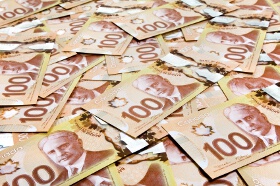The Canadian dollar was trading in the red for the most part today. The loonie was flat against the Japanese yen and gained on the Australian dollar but dropped versus the rest of the most-traded currencies. This is surprising considering the strong rally of crude oil, Canada’s major export commodity.
Futures for North American crude oil jumped more than 18%, while the global benchmark Brent grade rallied more than 12%. Usually, the Canadian currency follows moves of crude, but it was not the case today.
Statistics Canada released the scheduled report on gross domestic product on Thursday. Being significantly delayed, it was of limited interest to traders, showing a snapshot of the Canadian economy before it was hit by the coronavirus pandemic. The agency released a flash report two weeks ago, which provided more up-to-date information. As for today’s report, it showed that Canada’s gross domestic product was unchanged in February, whereas economists were counting on the same 0.2% rate of growth as in the previous month. There were two major detrimental factors for economic growth. The first one was the teacher strikes in Ontario. The second one was the decline in the transportation and warehousing sector due to rail blockades and a train derailment near Saskatoon.
The Industrial Product Price Index decreased by 0.9% in March versus the forecast decrease of 1.9%. The drop was driven primarily by lower prices for refined petroleum energy products. The Raw Materials Price Index slumped by 15.6%, in line with market expectations. Lower prices for crude oil were the main contributor to the decline.
USD/CAD rose from 1.3877 to 1.3924 as of 17:18 GMT today. EUR/CAD jumped from 1.5083 to 1.5230. AUD/CAD was down from 0.9097 to 0.9085 but bounced from the session low of 0.9028.
If you have any questions, comments, or opinions regarding the Canadian Dollar, feel free to post them using the commentary form below.
Canadian Dollar Soft Despite Rally of Crude Oil
